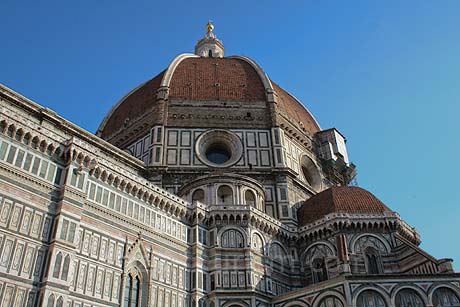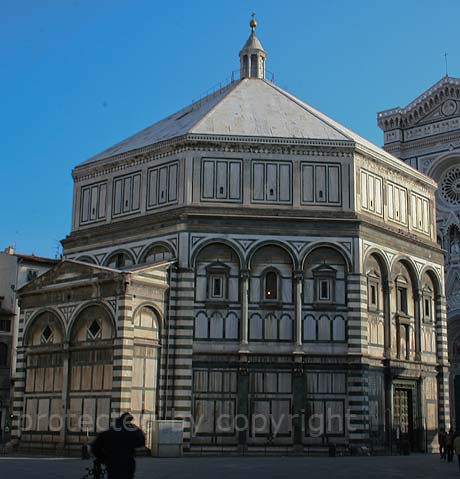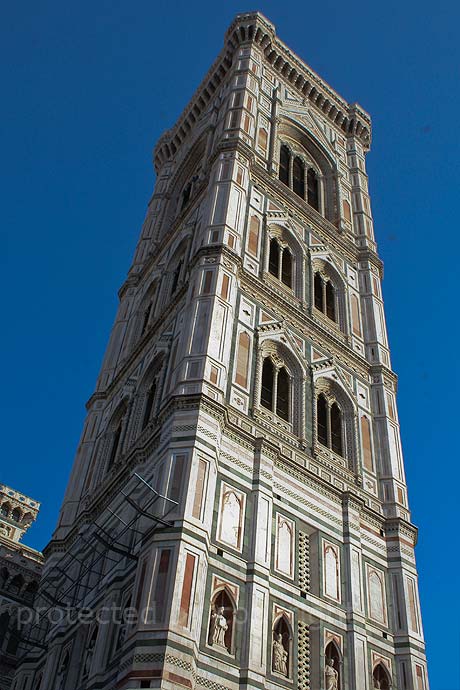Florence Piazza del Duomo

Of all the other piazzas in Florence, Piazza del Duomo makes its way though by several features unmatched within the capital of Tuscany by its tourist counterparts. First of all, Piazza del Duomo lies in the very historic center of Florence, which is enough to say that, even if only geographically speaking, the respective piazza has a privileged position. Yet, it is by its statute as ultimate tourist hotspot that Piazza del Duomo stands out in sharp relief in the overcrowded picture of tourist attractions in Florence. Thus, the piazza clusters a series of undeniable objectives with great historical, religious, architectural, artistic and cultural charge, and these landmarks refer to the Cathedral of Santa Maria del Fiore, to the Baptistery of St. John, to the Bell Tower (Campanile), to the Cathedral Museum (Museo dell’Opera del Duomo), as well as to Loggia del Bigallo. Other notable objectives, though not as renowned as the ones abovementioned, are represented by the Palazzo dei Canonici, Palazzo Archivescovile, Palazzo Strozzi di Mantova, by the Torrini Museum, Torre dei Marignolli, Opera di San Giovanni and the Venerabile Arciconfraternita della Misericordia, for instance.
Florence Duomo
The Cathedral of Santa Maria dei Fiori of Florence (Il Duomo) is the one which overtops, both dimensionally and by significance, the other landmarks of Piazza del Duomo, constituting, along with the Baptistery and the Campanile, a UNESCO World Heritage Site. As architectural performances, one can cite the fact that this edifice used to be the largest cathedral in the world until the modern era. Nowadays, as far as Italian religious establishments go, the Cathedral of Santa Maria dei Fiori is the third largest of all, after the Cathedral of St. Peter in Rome (Vatican) and the one in Milan. The history of the cathedral goes back to the late 13th century (1296), when Arnolfo di Cambio was commissioned to design the edifice, which he did, at least in part, in a majestic Gothic style. Yet, it was not until 1436 that the construction proper completed under the supervision of Filippo Brunelleschi, the 140 years interposed between the beginning and the completion of construction works having given to other genius architects – such as Giotto, Andrea Pisano, Francesco Talenti and Giovanni Ghini – the opportunity to bring their contribution to the erection of the monumental edifice. However, it seems as if the construction and the embellishment of the cathedral had the power of summoning a significant part of the most valuable Renaissance artists, since among the contributors one should also cite Michelangelo, Donatello, Ghirlandaio, Nanni di Banco, Lorenzo d’Ambrogio, Niccolo Lamberti, Giorgio Vasari, Luca della Robbia.

The project of the Cathedral started when Florentines ascertained the decay of the former Cathedral of Santa Reparata (on the site of which the latter Santa Maria dei Fiori was to be built) and the impossibility of fighting this condition by endless repairs and restorations. As a curiosity in this respect, Santa Maria dei Fiori was actually constructed around Santa Maria Reparata, la latter being completely dismantled only 70 years after the beginning of the construction. All in all, the main highlights of the Cathedral of Santa Maria dei Fiori refer to the dome as such, to the overall exterior look – façades included – to its sacristies, aisles, apses; briefly, all elements characteristic of any given religious establishment are brought to a new level and standard of artfulness. Thus, what is striking about the exterior of the cathedral is its rich polychrome ornamentation, an effect yielded by the combination of colors, materials and sculptural motifs, as well as by the various religious scenes embellishing the façade, the rose window, the spandrels, the lunettes, the columns. In contradistinction to the exterior, the interior surprises by the scarcity of decorations, though certain valuable masterpieces can definitely be found within the edifice, such as the statues of the apostles, a fresco by Giotto in the south apse, the stained glass windows in the north apse, conceived by Ghiberti, for instance.
On top of all, the one which overlooks the interior of the cathedral is Vasari’s fresco rendering the Last Supper (a work conceived by Vasari but chiefly carried out by Frederico Zuccari). All these matters aside, anyone can tell that the architectural value of the cathedral lies within its dome, a monumental structure designed by Brunelleschi, the last chief architect commissioned for this task. Michelangelo is said to have made some rough comments on what the dome started to look like when Brunelleschi was working at it, though, on the other hand, the Cathedral Santa Maria dei Fiori is known to have inspired to a great extent the design and the construction of the Basilica of Saint Peter in Vatican to which Michelangelo, for that matter, took part. The bottom line is Santa Maria dei Fiori is one of the most exquisite expressions of the fortunate alliance between Gothic inclement lines and curves and the docility of the basic material used in its construction, that is, marble.
- Name:
- Il Duomo
- Address:
- 17 Piazza del Duomo, Florence
- Telephone:
- 0039 (0)55 215380
- Fax:
- 0039 (0)55 215380
- Website:
- www.duomofirenze.it
Baptistery of St. John
The Baptistery of St. John (Battistero di San Giovanni) – or, briefly, the Baptistery – complements the contribution of Santa Maria dei Fiori to the architectural asset of Piazza del Duomo. Dubbed the minor basilica of Florence, the Baptistery is one of the oldest buildings in the capital of Tuscany, allegedly constructed on the site of a former Roman temple of Mars. It was built between 1059 and 1128 in a Romanesque style, and its architectural value has been ascertained and appreciated by Dante and Michelangelo alike, for instance. Truth be told, the Baptistery, besides adjoining Santa Maria dei Fiori and the Bell Tower in Piazza del Duomo, also borders on one side the smaller neighboring Piazza di San Giovanni. Until today, there is no clear reference as to the architect who designed the structure, though Andrea Pisano, Giotto Giovan Rustici, Andrea Sansovino, Ghiberti and Vicenzo Danti, as well as Donatello and Michelozzo are ascertained as to their contribution to the finishing of the edifice. Allegedly, Leonardo da Vinci too has contributed, even if not directly and only as supervisor, to the artistic value of the Baptistery.
Thus, the octagonal plan of the edifice is, in fact, typical of the baptisteries built during the first millennium of Christianity, and its merits refer to the fact that it holds the whole structure in symmetric proportions. However, the Baptistery of San Giovanni in Florence stands out by the invaluable sculptural masterpieces which used to populate its exterior and interior until the originals were sheltered against wear in the Cathedral Museum (also located in Piazza del Duomo) and replaced with replicas. The chief material used for finishing the surfaces is marble of various colors (the extensive use of which was a tradition in Florence at that moment), but bronze too was highly used in designing and constructing the doors (portals) of the Baptistery. As compared to the florid decorations on the outer structure of the Baptistery, the interior of the edifice is rather bare, though there are certain masterpieces which do complement the artistic value of the place. Thus, the Baptistery takes pride in featuring one of the largest and finest mosaics in the Western art, a mosaic which is in amazing contradistinction to the overall dash of the interior, several artists having worked at it in time (Jacopo da Torrita, Gaddo Gaddi, Cimabue, Andrea di Riccio).

Donatello is yet another resonant name with a fair share of works displayed in the Baptistery, such as the sarcophagus of Bishop Ranieri, the shrine featuring an angel-shaped candlestick and a wooden Mary Magdalene. The latter, for that matter, has been removed from the Baptistery and sheltered in the Cathedral Museum. Yet, it is chiefly in the doors of the Baptistery that the artistic value of the edifice lies. These bronze portals feature amazingly artful bas-reliefs and they enhance the significance of the Baptistery despite the fact they have been added to the edifice about two centuries after its construction. Thus, the south portal is the oldest of all. It was designed by Andrea Pisano during the first half of the 14th century, and the 28 Gothic panels of which the portal consists render religious scenes related mainly to the life of John the Baptist. Vittorio Ghiberti too shared in the realization of the south doors by the decorations embellishing the framing of the portal. The north portal is the result of the work of an entire team of artists – Bernardo Ciuffagni, Bernardo Cennini, Masolino, Donatello, Paolo Uccello – captained by Lorenzo Ghiberti, and though Ghiberti intended to follow the structure implemented by Andrea Pisano in the south doors – 28 panels depicting religious scenes – his work managed to exceed by technique and artfulness the climaxes achieved by Pisano. The latest addition refers to the east portal (built between 1425 and 1452) by the same Ghiberti, and by force of the artistry of his work, the original portal has been replaced with a replica subsequently to being transported to the nearby Cathedral Museum. Dubbed the Gate of Paradise, the reason of this surname – owed to Michelangelo – does not refer to the scenes depicted, but precisely to the perfection of the work.
- Name:
- Battistero di San Giovanni
- Address:
- Piazza San Giovanni, Florence
- Telephone:
- 0039 (0)55 230 2885
- Website:
- www.operaduomo.firenze.it
Florence Campanile
The Campanile adjoining the Cathedral of Santa Maria dei Fiori is yet another attraction to enhance the architectural and, hence, the tourist rating of Piazza del Duomo. Also referred to as Giotto’s Campanile due to the fact Giotto (who actually built only the first level of the bell tower) was the first architect commissioned to conceive the structure neighboring the cathedral (in 1334), the completion of the Campanile (in 1387) required the privities of Andrea Pisano (2 levels) and Francesco Talenti (3 levels). The Campanile features a strikingly Gothic profile lightened by the polychromic touch of the marble finishing and highlighted by the florid sculptural display. Andrea Pisano, the successor of Ghiberti to the construction of the Campanile, closely followed the architectural plans and intentions of his predecessor, though Francesco Talenti is ascertained as having averted from the original project. The bottom line is the Campanile, despite such circumstances, has a unitary look and that the coherence of its elements outrivals the possibly occurring differences between them. The main highlights of the Campanile refer, for instance, to the outer hexagonal panels on the first floor rendering various allegories and biblical scenes, most of them created by Andrea Pisano, whereas the rest is attributed to Nino Pisano and Luca della Robbia, respectively. The lozenge-shaped panels on the first floor are, again, in part attributed to Andrea Pisano, though Maso di Banco, Nino Pisano and Micheli de Castello too have created some of them. The niches of the Campanile are populated by sculptural works of art, statues and bas-reliefs alike attributed to Andrea Pisano, Maso di Banco, Donatello and Nanni di Bartolo. However, they are all displayed at the Cathedral Museum, their rightful place being taken by copies.
- Name:
- Florence Campanile
- Address
- Piazza del Duomo, Florence
- Telephone:
- 0039 (0) 55 230 2885
 Go to top
Go to top